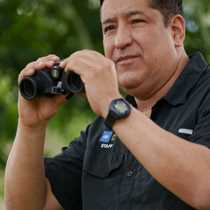Santa Cruz Island
Today in the morning we all woke up with high spirits and even higher expectations. We would spend the whole day learning about the incomparable Galápagos Giant Tortoises. Right after breakfast we started our expedition.
After a short bus ride and a walk, we arrived at the Charles Darwin Research Station’s Tortoise Breeding Center. We began observing young hatchlings that today were very active moving all over their pens. One of the most exciting moments of the day was when we approached the famous “Lonesome George”. This venerable tortoise is unfortunately the only remaining individual from Pinta Island. He is not so lonely after all, for George has the company of two attractive female tortoises from Española Island. This company is provided to him as part of an effort to try to save his subspecies by encouraging him to mate. George seemed not in the mood today, for he was seen snoozing without paying much attention to the females. Our guests were fascinated by the fact that they could observe the difference in carapace shapes between the tortoises in the different corrals. The latter was specially noted while observing how an Española Island tortoise extends its long neck. Another famous tortoise, Diego, lived in the San Diego Zoo for many years after coming back to help save his race. He has been quite successful for he is the proud prolific father of hundreds of Galápagos baby tortoises.
After visiting the Darwin Centre we had the joy to walk along the streets of Puerto Ayora. Sightseeing and shopping were popular activities that allowed our guests to take home handicrafts and memories of this fantastic expedition. We rode buses once again and went to the highlands of Santa Cruz Island. An intrepid group of twelve cyclists biked the last four miles before arriving at “Altair”, a picturesque restaurant where we had lunch. We all made a brief but fascinating stop before arriving at the restaurant, we visited a sugar cane farm where a local Galápagos family showed us how they cultivate, process and make a living by growing sugar cane and coffee.
After lunch, a bus ride took us to see the giant tortoises in the wild. We saw many of them and we all had the rare but unforgettable opportunity to contemplate in a relaxed fashion while mingling among these antediluvian- looking giants.
While writing these paragraphs I still feel the happiness that a group of local professional dancers and musicians brought onboard. They performed live music for us as a golden finale of this day in our lives that was dedicated in its totality to the most emblematic animal species not only of the Galápagos but of Ecuador, the amazing Galápagos Giant Tortoises.




